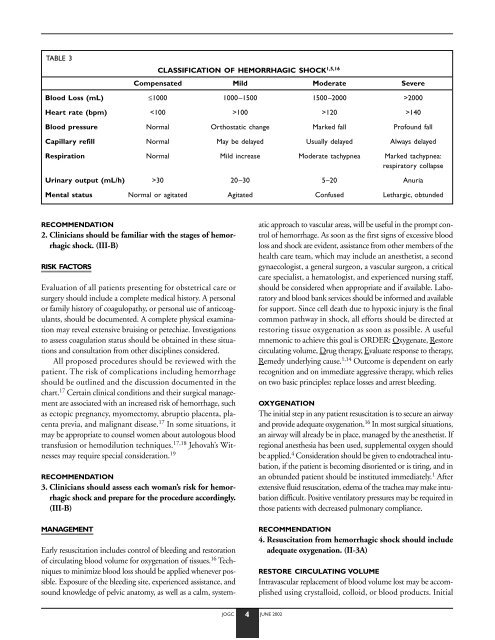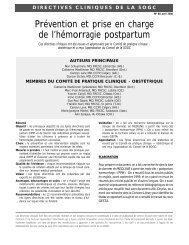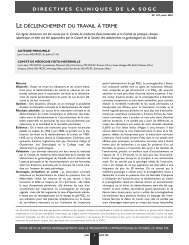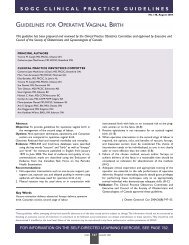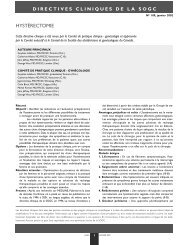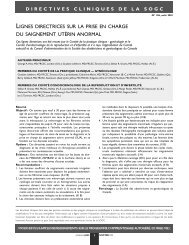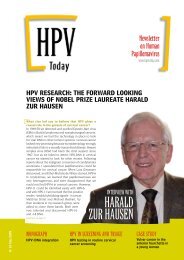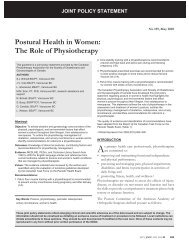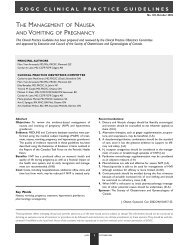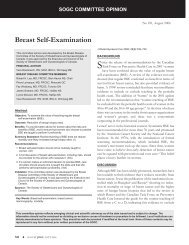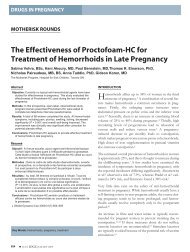Hemorrhagic Shock - SOGC
Hemorrhagic Shock - SOGC
Hemorrhagic Shock - SOGC
You also want an ePaper? Increase the reach of your titles
YUMPU automatically turns print PDFs into web optimized ePapers that Google loves.
TABLE 3<br />
RECOMMENDATION<br />
2. Clinicians should be familiar with the stages of hemorrhagic<br />
shock. (III-B)<br />
RISK FACTORS<br />
Evaluation of all patients presenting for obstetrical care or<br />
surgery should include a complete medical history. A personal<br />
or family history of coagulopathy, or personal use of anticoagulants,<br />
should be documented. A complete physical examination<br />
may reveal extensive bruising or petechiae. Investigations<br />
to assess coagulation status should be obtained in these situations<br />
and consultation from other disciplines considered.<br />
All proposed procedures should be reviewed with the<br />
patient. The risk of complications including hemorrhage<br />
should be outlined and the discussion documented in the<br />
chart. 17 Certain clinical conditions and their surgical management<br />
are associated with an increased risk of hemorrhage, such<br />
as ectopic pregnancy, myomectomy, abruptio placenta, placenta<br />
previa, and malignant disease. 17 In some situations, it<br />
may be appropriate to counsel women about autologous blood<br />
transfusion or hemodilution techniques. 17,18 Jehovah’s Witnesses<br />
may require special consideration. 19<br />
RECOMMENDATION<br />
3. Clinicians should assess each woman’s risk for hemorrhagic<br />
shock and prepare for the procedure accordingly.<br />
(III-B)<br />
MANAGEMENT<br />
Early resuscitation includes control of bleeding and restoration<br />
of circulating blood volume for oxygenation of tissues. 16 Techniques<br />
to minimize blood loss should be applied whenever possible.<br />
Exposure of the bleeding site, experienced assistance, and<br />
sound knowledge of pelvic anatomy, as well as a calm, system-<br />
CLASSIFICATION OF HEMORRHAGIC SHOCK 1,5,16<br />
Compensated Mild Moderate Severe<br />
Blood Loss (mL) ≤1000 1000–1500 1500–2000 >2000<br />
Heart rate (bpm) 100 >120 >140<br />
Blood pressure Normal Orthostatic change Marked fall Profound fall<br />
Capillary refill Normal May be delayed Usually delayed Always delayed<br />
Respiration Normal Mild increase Moderate tachypnea Marked tachypnea:<br />
respiratory collapse<br />
Urinary output (mL/h) >30 20–30 5–20 Anuria<br />
Mental status Normal or agitated Agitated Confused Lethargic, obtunded<br />
JOGC 4 JUNE 2002<br />
atic approach to vascular areas, will be useful in the prompt control<br />
of hemorrhage. As soon as the first signs of excessive blood<br />
loss and shock are evident, assistance from other members of the<br />
health care team, which may include an anesthetist, a second<br />
gynaecologist, a general surgeon, a vascular surgeon, a critical<br />
care specialist, a hematologist, and experienced nursing staff,<br />
should be considered when appropriate and if available. Laboratory<br />
and blood bank services should be informed and available<br />
for support. Since cell death due to hypoxic injury is the final<br />
common pathway in shock, all efforts should be directed at<br />
restoring tissue oxygenation as soon as possible. A useful<br />
mnemonic to achieve this goal is ORDER: Oxygenate, Restore<br />
circulating volume, Drug therapy, Evaluate response to therapy,<br />
Remedy underlying cause. 1,14 Outcome is dependent on early<br />
recognition and on immediate aggressive therapy, which relies<br />
on two basic principles: replace losses and arrest bleeding.<br />
OXYGENATION<br />
The initial step in any patient resuscitation is to secure an airway<br />
and provide adequate oxygenation. 16 In most surgical situations,<br />
an airway will already be in place, managed by the anesthetist. If<br />
regional anesthesia has been used, supplemental oxygen should<br />
be applied. 4 Consideration should be given to endotracheal intubation,<br />
if the patient is becoming disoriented or is tiring, and in<br />
an obtunded patient should be instituted immediately. 1 After<br />
extensive fluid resuscitation, edema of the trachea may make intubation<br />
difficult. Positive ventilatory pressures may be required in<br />
those patients with decreased pulmonary compliance.<br />
RECOMMENDATION<br />
4. Resuscitation from hemorrhagic shock should include<br />
adequate oxygenation. (II-3A)<br />
RESTORE CIRCULATING VOLUME<br />
Intravascular replacement of blood volume lost may be accomplished<br />
using crystalloid, colloid, or blood products. Initial


